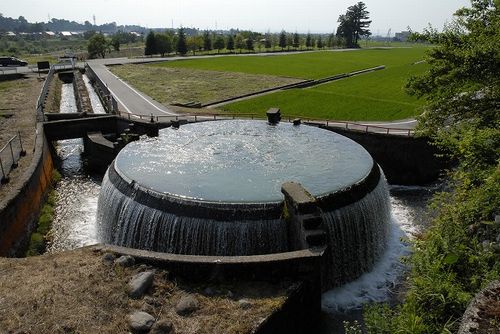August 10, 2012
Uozu City Designates 30 Natural and Cultural Heritages Associated with the Water Cycle
Keywords: Ecosystems / Biodiversity Local government Water

Copyright Uozu City
The continuous movement of water in the form of rivers, lakes, and groundwater shapes the landscape and history of a region. To appreciate this part of the water cycle as a precious resource to pass down to future generations, the city of Uozu in Japan's Toyama Prefecture designated in April 2012, 30 natural and cultural assets associated with local water as the city's "water cycle heritage."
Rising steeply from sea level to an elevation of over 2,400 meters in a distance of just 25 kilometers, Uozu commands an entire view of its natural hydrological systems. Its water cycle heritage list includes such natural features as the Kekachi Mountains, a watershed for the Katakai and Hayatsuki rivers, which flow through the city, as well as the delta fans those rivers create. An inferior mirage commonly seen across the Toyama Bay was also registered.
Apart from landforms and natural phenomena, the list also includes tangible and intangible cultural assets that illustrate human's connection to water. These include dams for managing the rapid flow of rivers; half-century-old circular tanks used to divide irrigation water equitably among multiple farming communities, technologies that are still in use today; and even poems portraying the beautiful waters of Hayatsuki River in the Manyoshu, the oldest existing collection of Japanese poetry.
By designating a water cycle heritage, Uozu aims to raise awareness of the local water cycle and encourage citizens to work together to keep it healthy.
Japan's Toyama Bay: Working to Restore the Links between Forests, Rivers, and the Sea
Posted: 2012/08/10 06:00:15 AM
Related
"JFS Newsletter"
- Fifth Contest to Award Excellent Environmental and Social Practices by Junior High, High School Students
- TMG Sewerage Bureau Aims to Make Tokyo a 'Smart Energy City'
- Learning from the Past: Traditional Flood Control Systems in Japan's Kofu Basin
- Yahaba Waterworks Supporters Workshop -- Citizens Decide on the Future of the Water Supply
- Arase Dam: Japan's First Dam Removal Project Underway
Related
"Popular Articles"
- Cabinet of Japan Decide to Make Full Use of Rainwater in Newly Constructed Buildings
- Japan Facing Water Shortages in Some Areas: 2010 Water Resources Report
- A Cup of Water Saving Children's Lives
- MOE Publishes Cases of Water Footprint Calculations to Visualize Water Use
- Japanese Technology to Help Address Global Water Problems


